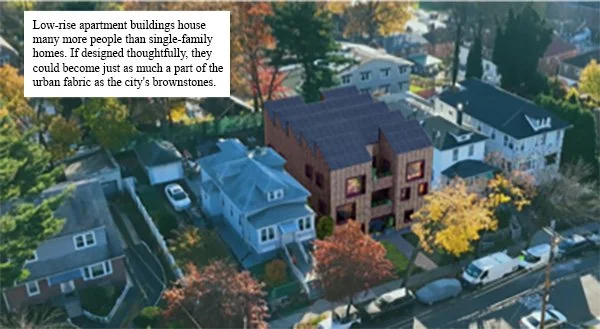Sometimes You Need To Destroy a Perfectly Good Mansion
This article was originally published, in slightly different form, on Strong Towns member Will Gardner’s Substack, StrongHaven. It is shared here with permission.
(Source: New Bedford Whaling Museum via the Standard-Times.)
Recently, the Times had two related pieces that, despite being about a city that’s over 500 times larger than my town of Fairhaven, Massachusetts, hold some important lessons for a community of any size.
Binyamin Applebaum, in the piece “I Want a City, Not a Museum,” revisits the homes of previous generations of his family and remarks:
I take pleasure in wandering around this museum of family history, but it also makes me sad. The buildings survive because New York is preserving the corporeal city of bricks and steel at the expense of its residents and of those who might live here.
It’s a beautifully written piece that manages to celebrate the beauty of things from our past while being clear-eyed about the cost of their reification.
Our little town of Fairhaven was home to the robber baron Henry Huttleston Rogers, whose grand estate (pictured above) once stood on the peninsula where my neighborhood is. After Rogers died, his kids didn’t want the mansion, so they offered to sell it to the town for a buck.
The town couldn’t afford to maintain it, so they decided to tear it down. Instead of serving as a museum of the Gilded Age, the land where the estate once stood is used for a park, public beach access, and a residential neighborhood where hundreds of people live.
The decision to tear down the Rogers estate is still considered controversial by some, who see the demolition of the mansion as a great loss to the town. The house was, of course, stunning and would be fun to visit, had it been preserved. But, in hindsight, most rational people would agree that we would be nuts to trade an entire neighborhood—along with a beautiful public beach area, not to mention the tax revenue the current land use generates for our schools, police, fire, and other services—to preserve a nice house so that people could look at it. The town made the right call!
Let’s take the thinking further, though. Because, while the town leaders had the foresight to lovingly say goodbye to history to make way for a beautiful future, their successors did not. The neighborhood that grew up in the place of and around the Rogers estate is lovely in its own right, though of course lacking the grandeur of Chez Rogers. But, thanks to the web of zoning laws and building codes put in place over the past 100 years, this area is now essentially encased in amber.
The town leaders who decided to tear down the mansion did not live in a time of cheap debt financing, which might have enabled them to punt on tearing down the mansion and push its maintenance costs onto future generations. They were acutely aware of the trade-offs that this obligation would represent to the town. Preserving the Rogers Crib was a bad deal for the town, and there was no way to paper that over and call it a win.
As we look to the future of the neighborhood that now sits on and around the former estate, our leaders would be wise to think as their forebears once did. Freezing the neighborhood in time means rising home prices for the few privileged enough to live there. It means that tax revenue and per-acre productivity increasingly lose pace to the rising cost of town services, pushing the town into debt and forcing more brutal trade-offs between raising taxes and cutting vital services.
As I’ve outlined here previously, the best place to put new housing is in neighborhoods where housing already exists. We already have the infrastructure and thickening these neighborhoods makes them better places to live for most people. The NIMBY argument that adding housing, however incrementally, throughout our existing neighborhoods would somehow destroy their “character” seeks to thwart the very process of growth and evolution that created these neighborhoods, in the first place. What’s more, we could add enough housing to dramatically increase the town’s financial standing (and thus quality of services, etc.) without noticeably changing the overall look of the neighborhoods. (For the record, I’m OK with the look changing!)
This brings me to the second Times piece, “How to Make Room for a Million New Yorkers.” One of the key opportunities the authors highlight here is the ability to infill low-rise apartment buildings in vacant lots in more suburban parts of the city. Check out what it looks like in this area of the Bronx, which has similar land use patterns to much of Fairhaven:
Does this destroy the character of the neighborhood? If you object to the modern style of the building, just imagine then that it’s more in the style of some of the multi-families that already exist here. Blah blah, parking. Now imagine a few of these sprinkled on currently vacant lots, alongside a wave of accessory dwelling units and the ability of homeowners who can increase their land to the next increment of development (a two-family home could become a three-family home, etc.). This is the kind of growth that would be a boon to local contractors and small developers. It would also mean we could have a vibrant, walkable downtown once again. Better services without dramatic tax hikes. Increased population and land values might even mean (I don’t understand it, but some of you go nuts for this) a Trader Joe’s?!
Just remember there is no cost-free “keep this neighborhood the same” option. Our town forefathers knew this and didn’t shy away from making hard choices in the face of it. If you live in Fairhaven today, you should be grateful that past leaders made decisions with future generations first and foremost in their minds. Let’s pass it forward to subsequent generations in this town, whether they are kin to us or new arrivals. Vibrant, diverse neighborhoods, livable streets, and financial solvency are a legacy far more lasting and valuable than any attempt at mid-century neighborhood taxidermy.
Will Gardner is an education consultant and the founder of Alma del Mar Charter Schools. He’s currently scheming about how to improve his town, but he’s happy to help you with whatever you’re working on. You can find him at StrongHaven.substack.com.







